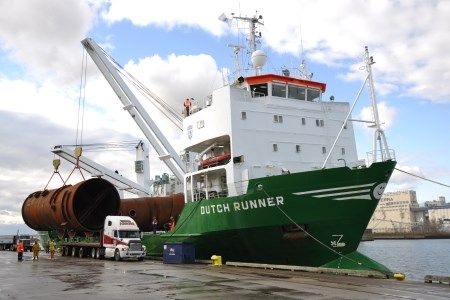Believe it or not, the recession has been kind to the Port of Thunder Bay.
In the last three years, the historic grain and coal port has garnered an international reputation for handling a diverse mix of project cargoes headed for Western Canada.
In September, a shipment of 50 wind turbines and the components for 13 windmills arrived at Keefer Terminal aboard the saltwater vessel Beluga Favourisation.
Originating in Emden, Germany, the cargo was loaded onto trucks headed for the Castle Rock Ridge Wind Farm in Alberta. The ship was then loaded with flax for the return trip to Europe.
It was one of five turbine cargoes arriving at the port this year with more coming in 2011.
“Our biggest growth was during the recession and it’s been pretty encouraging so far,” said Tim Heney, CEO of the Thunder Bay Port Authority.
“There’s huge potential in inbound material and since the supply chain is so competitive, we also have the outbound (grain cargoes).”
In recent years, the port’s marketing strategy has been focused around attracting more westbound project cargoes for customers in the Alberta oil sands.
Though grain and coal have always been traditional outbound cargoes, Heney is pleased with the variety of inbound freight that continues to move through Keefer Terminal, including a Chinese-built methanol plant bound for Edmonton and a bridge assembly, fabricated in Spain, that headed to Calgary.
“The project cargo for the oil sands hasn’t really revived yet. It’s probably going to be another year before we start moving equipment.”
Wind turbine cargoes have filled the gap. “The success we’ve had has made us very optimistic about the future. There’s big potential here and we’ve only scratched the surface.”
Heney said the emerging mining camp in the James Bay Ring of Fire offers a potential opportunity. If the chromite smelter and processing facilties are located in Thunder Bay, it could mean moving one million tons of material by ship. There is also the possibility of loading Canadian pulp for shipment to Europe.
“Everything is new to us. You never know what you’re going to get.”
Global trade patterns over the last 20 years have not been kind to the St. Lawrence Seaway. But Heney expects to see dramatic changes ahead in the movement of freight in North America, starting with the coming expansion of the Panama Canal. How that will impact the Seaway is not clear, but an estimated 28 per cent of the cargo will move away from the West Coast toward ports on the Atlantic.
Heney said many ocean shipping companies ordered new vessels prior to the recession. With the demand for vessels down and those new ships now coming into service, the companies have lowered their rates and are looking upon the Great Lakes as an opportunity.
“I was just down at a break-bulk conference in Houston and I’ve never seen so many European ocean companies looking at the Seaway as an option,” said Heney. “It’s been an interesting time because the economic downturn has probably helped us.”
Their main competitors for Western Canada and oil sands project cargoes and turbines are Houston, Texas and their U.S. neighbour on Lake Superior, Duluth, Minn.
Marketing Thunder Bay to shippers is as much about “selling the route” through the St. Lawrence Seaway. Since shipping by water is cheaper than by rail or truck, Heney sells the merits of moving marine freight inland into the heart of North America to the western-most Canadian port in the Seaway chain and then directly by rail to Western Canada.
It also involves co-ordination between the grain handlers and shipping companies in arranging back-haul cargoes for these ships.
“This year we were able to get back-haul cargoes (of grain) for five project boats for Europe,” said Heney. “That’s a really big attraction for Thunder Bay.”
Though small for ocean-going vessels at only 10,000 to 15,000 tons, Heney said it’s a good way to move grain because of the lower vessel rates.
Heney said what’s coming into vogue in North American logistics circles is reducing carbon footprint. The recession forced many ocean container shipping companies to cut their speed in half to save fuel. It’s just about killed the just-in-time supply chain which makes the Seaway as competitive as other ports.
There are changes coming in new fleet renewal on the Great Lakes.
The federal government’s elimination of a 25-per-cent import on foreign-built ships could have wide-ranging environmental and economic advantages.
As founder of the Ontario Marine Transportation Forum, Heney calls this a “really big breakthrough” as Canadian shipping companies will likely order new vessels.
The last ship built on the Great Lakes was launched in Collingwood in 1985 and the average age of a Canadian-flagged ‘laker’ is 38 years old.
Heney said the next generation of ships will be built in Chinese shipyards and will have a better carbon footprint with great efficiencies and more cargo-carrying capacity, making the Seaway more competitive.




